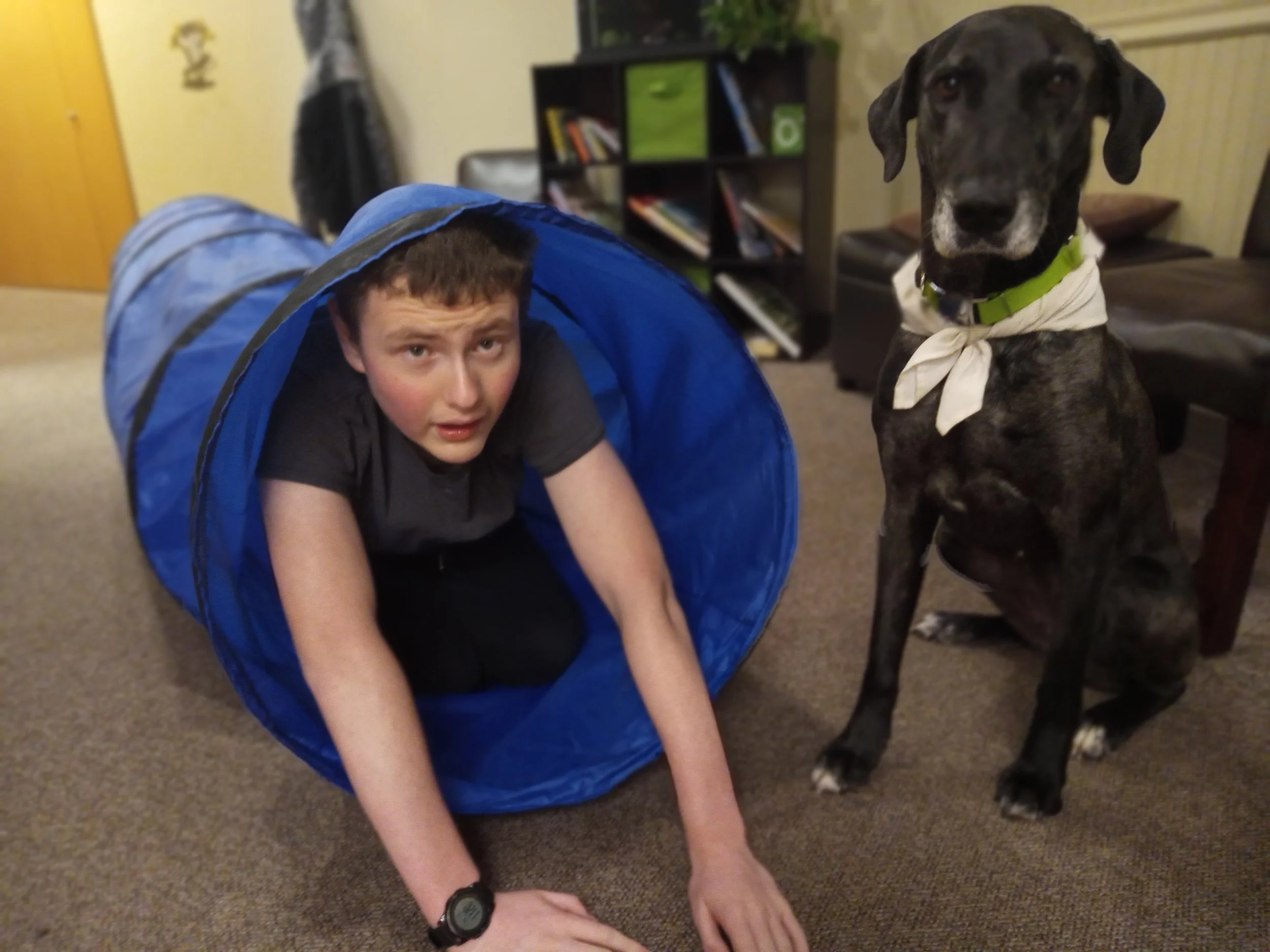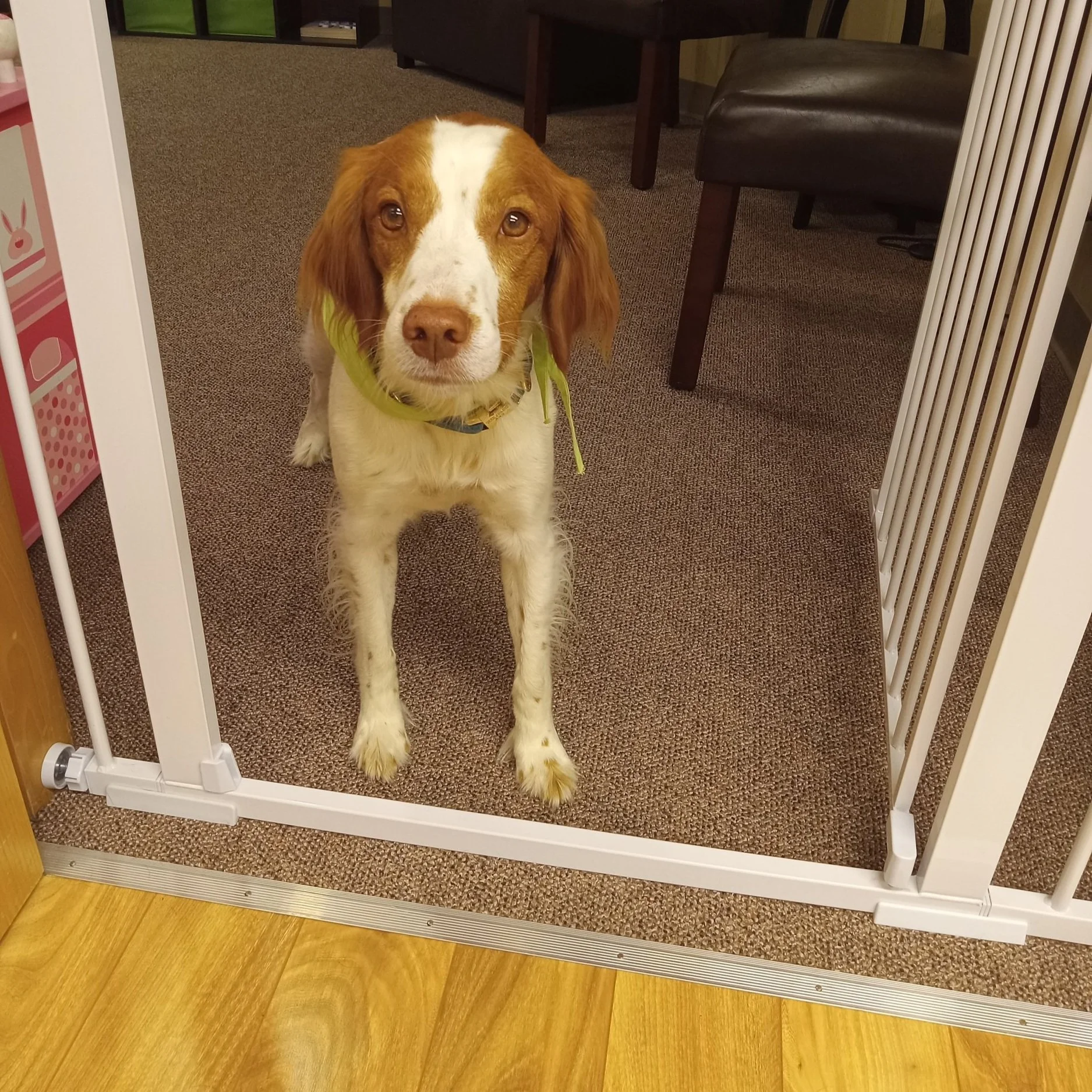Tricks AND Treats for Your Speech Therapy Dog
“Oh Delta, you’re soooo lazy today!” I groaned, hamming it up for the giggling first grader as my canine co-therapist barely lifted her legs high enough to make it through the hula hoop we were holding together.
Working on symmetrical lip protrusion for the “j” sound as part of post brain-surgery speech rehabilitation, the little girl clearly didn’t care that Delta’s trick was sub-par.
In fact, the unexpected nature of Delta’s poor performance and the laughter it elicited may have even made this activity more memorable.
(To see a clip, click here.)
While Delta does indeed know several tricks, I’ve found the kids on my caseload are rarely critical of how she performs. They are far more impacted by the bond they share with her as they practice emerging self-regulation and communication skills.
There are certain skills that do come in handy across a day of animal-assisted speech therapy, however. Here’s my personal favorites, the ones I call upon most often, and the treats I rely on to reward Delta’s hard work:
Speech therapy dog Sky recently learned to give “high-five”, which has quickly become a client favorite!
If you click a link it’s likely an affiliate link and I will earn a small commission if you purchase. It does not cost you anything extra. If I don’t use and love a product, you won’t find it here!
My favorite therapy dog tricks for animal-assisted speech therapy
I love a good multi-tasker, and these tricks allow me elicit a lot of different sounds or phrases without having to train (and work to maintain) a lot of different skills:
“Shake” is always a favorite with kids and adults alike. Delta often offers her paw as communication that she wants a little space when meeting someone new, while Sky offers a paw and then uses the person’s hand as a step to stand up and try for a smooch.
Knowing your dog’s comfort level with having their paws handled and always monitoring to make sure children aren’t holding too tightly is important. If shake is in your therapy dog’s repertoire, however, there are countless words that can be incorporated depending on your speech target (e.g. “paw” for bilabials, “hand” for final consonants, “put it ‘there’” for “th”, etc.).
If your therapy dog feels comfortable having their paws handled for “shake”, then it’s fairly easy to shape that behavior into “wave” and/or “high-five”. I’ve found wave can really help ease transitions into and out of the therapy room by joyfully distracting a child who might feel stuck, and every kid loves a high-five for their accomplishments.
“Spin” is a great high-energy movement to alert kids who are stuck in a low-energy state. I often incorporate this into a game of Simon Says to get both dog and child moving. Teens sometimes enjoy trying to teach Delta to spin to the right, as she is decidedly one-sided, providing a non-threatening opportunity to discuss growth mindset and persistence.
“Jump” and running through a “tunnel” can also infuse energy into a session and can be great for increasing joint attention and shared enjoyment with kids who can be difficult to engage.
A tunnel can be incorporated with willing therapy dogs to increase engagement and infuse energy into a session. Here therapy dog Delta is providing an engaging opportunity for turn-taking in animal-assisted speech therapy.
Using puzzles designed for dogs, “find it” is my current favorite therapy dog game. Language clients can work on asking or answering where questions, we can take turns hiding the treats or practice congratulating the dog when focusing on social communication skills, and articulation clients can work on saying “treat” as just a few possibilities. I found tying strings through the pieces made it easier for my dogs to learn to remove the pieces.
(These are my favorite treats to put in the dog puzzles as they are small so my dogs can eat a lot of them but also a bit smellier than some to make them easier to sniff out. If you have kids who are sensitive to smell, these are a more sensory-friendly treat that also fits the puzzle well.)
Finally, teaching my therapy dogs to “step” on items allows kids to have power in directing the dog’s actions for a sense of autonomy. I use this command both with expressive language clients (giving choices between pieces of furniture for the dog to get on) and articulation clients (“step” for s-clusters or “go” for velars for example). My reading kids love to “teach” the dogs to read vowel patterns that are written on soft foam stepping stones the dogs can comfortably step on as the child directs.
With all therapy dog commands, remember the specific word you choose is not important. My dogs all follow my hand signals, so kids can use whatever word they need to practice and still get a response as I stand next to or behind the child and signal simultaneously with their spoken production.
Not getting a response? Is it because your therapy dog isn’t feeling secure and needs a bit more space, more support, or a break? Or do they need a little review outside of a session to freshen up their skills? I’ve found working with a speech therapy dog requires frequent troubleshooting—the “training” is never really done.
Therapy dog Delta awaits a treat from a child demonstrating a “hand plate” to safely feed her after performing a trick for animal-assisted speech therapy.
The “No-Glamour” commands my therapy dogs need every day
Some obedience skills are not flashy, just crucial to keeping interactions safe.
I taught my dogs “back” to get away from a situation, whether that’s a swing, a child who is becoming dysregulated, or a carefully stacked block tower. However, it can double as a fun first word or final /k/ sound to practice as many kids love feeling a sense of control over a therapy dog’s movements (see an example animal-assisted speech therapy moment with a child working on early expressive language and speech motor planning).
“Wait” is crucial for keeping my dogs behind a barrier, whether real or invisible, for safety reasons. As opposed to “stay”, I intend “wait” to mean the dog can get comfortable in any position they want or even retreat to their bed, just not come into a space right now.
Though I have sturdy and attractive baby gates I can close if needed, I can often keep my dogs outside the room I’m in with a wait command when a client is engaged in very active play that could be overstimulating or unsafe.
With two of the four dogs I’ve partnered with I needed to clearly delineate the threshold of the office door so they wouldn’t go into the hall unleashed as families entered and teaching “wait” came in handy.
I also use it every time I use the public restroom in the building’s lobby so my dog doesn’t pop out before me and surprise an unexpecting visitor in the hall as we exit, as well as when I open the car door to keep them from jumping into the parking lot without a leash.
Finally, “luring” isn’t a specific command, but allows you to direct a therapy dog to move around obstacles as needed. When I’ve had puppies to work with, it’s the first skill we practice to encourage focus. I can lure my therapy dog through a simple obstacle courses, to a specific spot near a child, or to perform a “trick” they aren’t specifically trained for.
See examples of these no-glamour” speech therapy dog skills here.
Check out my favorite dog-training resources on the Animal-Assisted Therapy Books and DVDs resource page.
Therapy dog Sky demonstrates waiting behind a threshold to stay safe when moving equipment is in use or a child needs space to calm down.
Will that be cash, credit, or treats? “Paying” your speech therapy dog
My speech therapy dogs are paid in treats. Lots and lots of treats. To balance keeping my dogs excited to work with keeping clients comfortable, I’ve found having a small variety of treats dispensed for different purposes comes in handy.
Sensory-friendly treats are those that don’t have a strong texture or smell, making it less offensive to clients with sensitive sensory systems. Charlee Bear Original Crunch are my personal favorites as their puffy shape makes them easy to hold for little hands that may have fine motor control challenges and my dogs there’s a variety of flavors to keep my therapy dogs from getting bored.
“Stinky treats” come in handy for hiding in puzzle toys or under objects as part of speech and language activities. They can also be alerting for a client in a low arousal state as long as they aren’t dysregulating from smelling too bad. Of the many I’ve tried I prefer Zuke’s Mini-Naturals as they are small enough my dogs can eat quite a few. Some children may find them a bit difficult to hold due to their small size however.
These “stinky treats” and a dog puzzle toy can be incorporated into animal-assisted speech therapy for clients to practice asking a therapy dog “Where?” questions, to increase joint attention skills, and to practice articulation in phrases such as “find it.”
I like to keep a variety of treats in my pocket or a treat pouch to be able to grab my dog’s attention quickly, as well to reward a spontaneous response such as the dog recognizing a child’s need for space and moving away on their own.
While I try my best to proactively teach dog etiquette and boundaries around their rest spots, the clients I work with are often impulsive and/or have difficulty following directions. If a child does something unexpected, such as running to the dog’s bed or grabbing her tail, I will immediately redirect the child and dispense a treat as quickly as possible to reward my dog’s impulse control and tolerance.
Finally, I keep larger treats, such as these all-natural chewers or Kongs stuffed with sunflower butter for a variety of purposes:
· older kids may feel rewarded if allowed to choose a “special treat” for the dog (see also How can I incorporate a speech therapy dog to better engage teens?)
· to keep a dog busy in their retreat space while I work with a child who is having an unsafe moment or has become dysregulated by the dog’s presence
· to allow the dog to decompress through chewing after a difficult session (for more, check out this Therapy Dogs Australia podcast on decompression for therapy dogs)
(I choose to use dehydrated meat products because of the health benefits I perceive for the dogs. However, some therapy dog organization recommend against or disallow due to the slight chance of bacterial infection being present. I inform families of the risk and check for immune-compromised status upon intake and while explaining dog etiquette in our first sessions and include hand-washing after giving the dog these treats.)
Be aware that some dog treats may contain gluten or other allergens if you have a client with specific allergies or sensitivities.
Therapy dog Delta waits while a toddler chooses treats as part of animal-assisted speech therapy. Delta’s willingness to perform tricks have helped this girl use her first words in a highly engaging and motivating context.
By the end of the day, my therapy dogs have performed countless “tricks”—both exciting and glamour-free—and been amply compensated with edible payments. Brains are tired, tummies are full, and many children have new memories to reinforce the communication skills they were practicing.
Curious to learn more? Check out Paws for Progress: Integrating Animal-Assisted Interventions into Your Speech-Language Pathology Practice, available now from ASHA Press!
And follow @Speech_Dogs on Instagram for daily glimpses into the world of animal-assisted speech therapy!
May your days be filled with puppy wiggles and children’s giggles,
Sharlet







